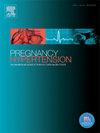Hypertensive disorders of pregnancy trends in the United States post aspirin recommendation guidelines
IF 2.9
4区 医学
Q2 OBSTETRICS & GYNECOLOGY
Pregnancy Hypertension-An International Journal of Womens Cardiovascular Health
Pub Date : 2025-04-03
DOI:10.1016/j.preghy.2025.101210
引用次数: 0
Abstract
Objective
To evaluate changes in the rates of hypertensive disorders of pregnancy (HDP) in the US after the publication of aspirin (ASA) recommendation guidelines by the USPSTF and ACOG.
Methods
A population-based retrospective cohort study was performed using the US Natality database. The pre-ASA group included births between 2010–2014. The post-ASA group were births between 2016–2021. Births in 2015 were excluded. Outcomes were rates of HDP. Univariate and multivariate analyses were performed. Using the 2010–2014 HDP trend, a projected trend was calculated and compared to the actual trend across the entire cohort.
Results
There were 12,127,659 births in the pre-ASA group and 17,665,217 births in the post-ASA group. The post-ASA group had a significantly higher rate of overall HDP than the pre-ASA group (7.7 % vs 4.9 %; aOR 1.58, 95 % CI [1.57–1.59]). When stratified by gestational age at delivery, the post-ASA group had a significantly lower rate of preterm HDP prior to 37 weeks (21.6 % vs 23.7 %; aOR 0.90, 95 % CI [0.89–0.91]) and preterm HDP prior to 34 weeks (6.0 % vs 7.5 %; aOR 0.79, 95 % CI [0.78–0.81]). The actual HDP trend post-ASA recommendation was higher than projected for overall HDP and preterm HDP < 37 weeks but was not different for preterm HPD < 34 weeks.
Conclusion
While overall HDP is increasing, the rate of preterm births complicated by HDP has been decreasing. The actual trend for the overall HDP category and the two preterm HDP categories, however, remains either higher or no different compared to the projected trend post aspirin recommendation guidelines.
美国阿司匹林推荐指南后妊娠高血压疾病趋势
目的评估USPSTF和ACOG发布阿司匹林(ASA)推荐指南后美国妊娠期高血压疾病(HDP)发生率的变化。方法采用美国Natality数据库进行基于人群的回顾性队列研究。前asa组包括2010-2014年间出生的婴儿。后asa组是在2016-2021年之间出生的。2015年出生的婴儿不包括在内。结果是HDP的发生率。进行单因素和多因素分析。使用2010-2014年HDP趋势,计算预测趋势,并将其与整个队列的实际趋势进行比较。结果asa前组分娩12127659例,asa后组分娩17665217例。asa后组的总体HDP率显著高于asa前组(7.7% vs 4.9%;(or 1.58, 95% CI[1.57-1.59])。当按分娩时胎龄分层时,asa后组37周前早产HDP率显著降低(21.6% vs 23.7%;aOR 0.90, 95% CI[0.89-0.91])和34周前早产儿HDP (6.0% vs 7.5%;aOR 0.79, 95% CI[0.78-0.81])。asa推荐后的实际HDP趋势高于总体HDP和早产儿HDP的预测。37周,但早产儿HPD <没有差异;34周。结论在新生儿总死亡率上升的同时,早产儿合并新生儿死亡率呈下降趋势。然而,总体HDP类别和两种早产儿HDP类别的实际趋势与阿司匹林推荐指南后的预测趋势相比仍然更高或没有区别。
本文章由计算机程序翻译,如有差异,请以英文原文为准。
求助全文
约1分钟内获得全文
求助全文
来源期刊

Pregnancy Hypertension-An International Journal of Womens Cardiovascular Health
OBSTETRICS & GYNECOLOGYPERIPHERAL VASCULAR-PERIPHERAL VASCULAR DISEASE
CiteScore
4.90
自引率
0.00%
发文量
127
期刊介绍:
Pregnancy Hypertension: An International Journal of Women''s Cardiovascular Health aims to stimulate research in the field of hypertension in pregnancy, disseminate the useful results of such research, and advance education in the field.
We publish articles pertaining to human and animal blood pressure during gestation, hypertension during gestation including physiology of circulatory control, pathophysiology, methodology, therapy or any other material relevant to the relationship between elevated blood pressure and pregnancy. The subtitle reflects the wider aspects of studying hypertension in pregnancy thus we also publish articles on in utero programming, nutrition, long term effects of hypertension in pregnancy on cardiovascular health and other research that helps our understanding of the etiology or consequences of hypertension in pregnancy. Case reports are not published unless of exceptional/outstanding importance to the field.
 求助内容:
求助内容: 应助结果提醒方式:
应助结果提醒方式:


